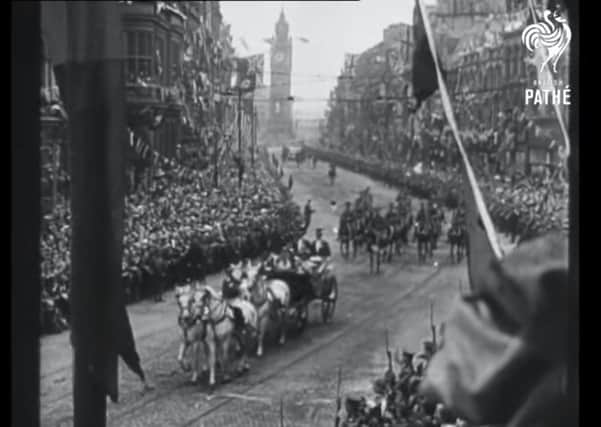Loyalist Belfast had been keenly awaiting the royals in 1921, when the king opened Northern Ireland’s new parliament


A fortnight after the May 1921 elections had handed Sir James Craig’s Unionist Party a massive majority in the new Parliament it was announced that King George V and his wife Queen Mary would formally open Northern Ireland’s first Parliament.
The following days and weeks witnessed considerable frenetic preparations, as the elected representatives, cabinet members and other officials were sworn in, and a full ‘rehearsal’ for the opening ceremony (involving the Lord Lieutenant, Lord FitzAlan) took place.
Advertisement
Hide AdAdvertisement
Hide AdThe king’s advisors were wary about his forthcoming visit to Ireland at such an uncertain time.


Sectarian violence, involving both the IRA and Belfast Protestant Association [BPA] had flared up once again the previous summer, and several murders, as well as evictions of Catholic families had already occurred in June.
The diversity in community opinion over the value of such a visit was starkly reflected in Belfast’s press on the morning of the royals’ arrival.
Drawing attention to the recent eviction of some 150 Catholic families from their homes – ‘victims of Orange intolerance and bigotry’ — the Irish News argued that the Belfast authorities had got their priorities wrong, describing the city as being both a ‘beflagged’ and a ‘besmirched’ one.
Advertisement
Hide AdAdvertisement
Hide AdThe Belfast News Letter was predictably more upbeat in its hopes for the occasion. Its editorial reminded readers that unionists were ‘still in full possession of all the rights and privileges of citizenship of the United Kingdom and as subjects of the King’.
Consequently the paper’s readers could be expected to ‘welcome King George and Queen Mary today not only out of loyalty to their persons and to the Crown and Constitution, but because they have graciously set the seal of their presence upon our new Parliament and therefore brought it in visible among the Parliaments of the Empire which acknowledge their rule’.
Loyalist Belfast had been keenly awaiting the arrival of the royals, particularly since it had been nearly two decades since the last visit of a monarch to the city, and Belfast’s unionist-leaning citizens were determined to savour every fleeting moment of the royals’ presence.
Preparations for the special occasion had been in progress for several weeks, both in the loyalist working class strongholds of the Shankill and Ballymacarrett districts, where the patriotic decorations, in the words of the first premier’s wife Lady Craig, were ‘extremely well done’ and ‘wonderful’, and also in the city’s central thoroughfares.
Advertisement
Hide AdAdvertisement
Hide AdHere, an ‘army’ of City Corporation workers (some 500 strong) had been busy in recent days, putting their final touches to the decorations.
The City Hall had been spruced up, and neighbouring buildings, as well as street furniture, were all decorated in patriotic bunting.
Stands accommodating close to 3,000 spectators, had been erected for distinguished guests and portraits of the royal couple (as well as many of Craig and Sir Edward Carson) were placed at strategic places along most of the route.
Restrictions to the sale of alcohol were in place, although enterprising street hawkers enjoyed a brisk trade, selling a plethora of loyal memorabilia, including miniature flags, patriotic rosettes and a special programme of the occasion (this sold for half a crown).
Advertisement
Hide AdAdvertisement
Hide AdApart from the dense crowds which had gathered in central Belfast, many others had flocked to higher vantage points, particularly in the north of the city (like Cave Hill and Bellevue) in order to spot the royal flotilla sailing up Belfast Lough.
Four planes entertained the large, excited crowds with a low-flying air display during the lengthy wait prior to the royals’ arrival, whilst on the ground below, large contingents of police and military moved through the crowds, searching properties near the route.
More resourceful spectators had remembered to bring fold-up chairs, and even ladders, to help them obtain better views.
All in all, it was very much a festival, holiday atmosphere, albeit one not enjoyed by all of Belfast’s citizens.
Advertisement
Hide AdAdvertisement
Hide AdThe Royal Yacht sailed up Belfast Lough during the mid-morning of Wednesday June 22. The weather was fine, if a little overcast, and several people would suffer heat exhaustion on the crowded streets later on that day.
On arriving at Belfast docks during the late morning, the royal party received a noisy salute from the military guns which had been assembled on Donegall Quay. Sir James Craig welcomed the royals at the dockside, and they were transported in an open landau up High Street and along Donegall Place to the City Hall.
Thousands of people, including numerous police and troops, lined the relatively short route and cheered the royal couple as they arrived at the City Hall.
Around noon, King George V and Queen Mary were escorted to specially-designed gilt thrones where, after prayers and a lusty rendition of the national anthem, the king delivered a stirring plea for peace and reconciliation across the whole of Ireland. He implored the assembled representatives:
Advertisement
Hide AdAdvertisement
Hide Ad‘I speak from a full heart when I pray that my coming to Ireland today may prove to be the first step towards the end of strife among her people, whatever their race or creed. In that hope, I appeal to all Irishmen, to pause, to stretch out the hand of forebearance and conciliation, to forgive, and to join in making for the land they love a new era of peace, contentment and goodwill.’
Predictably there was a mixed response to the king’s short visit and his speech from the two sections of the Northern Irish community. Certainly unionists were delighted.
The Belfast News Letter celebrated the memory of ‘a right royal day in the city’, whilst the Belfast Telegraph believed that the monarch’s address had ‘struck a chord in the hearts of his loyal citizens’. However, the Irish News was sceptical about the value of the royal address which it maintained had been ‘full of vague professions and pious good wishes’.
Barely 48 hours after the pageantry and celebration in Belfast had died down, the IRA displayed its unambiguous response to the king’s pleas. Republicans executed a low-risk operation aimed at military personnel returning to Dublin.
Advertisement
Hide AdAdvertisement
Hide AdDuring the morning of June 24, a military train was attacked by an IRA bomb squad led by Frank Aiken near Bessbrook, close to the newly-created border.
Six people and over 80 horses were killed when a remote controlled device destroyed the last carriage of a troop train.
This attack, and the subsequent high level of republican activity in Belfast, not to mention the apparent freedom of movement enjoyed by the BPA and other loyalist paramilitaries, illustrated that levels of tension would remain high within the respective communities, and these were ready for exploitation by the unscrupulous.
Thoughts of peace and reconciliation would be rapidly replaced by more familiar ones of fear and suspicion.
Advertisement
Hide AdAdvertisement
Hide AdThe result was that even more costly loss of life — especially in the first half of 1922 — would occur in the newly-born state, and particularly in its capital city.
• Dr Parkinson’s new book ‘A Difficult Birth — Northern Ireland’s Early Years 1920-25’ is published by Eastwood Books, Dublin, price £21.99
——— ———
A message from the Editor:
Thank you for reading this story on our website. While I have your attention, I also have an important request to make of you.
With the coronavirus lockdown having a major impact on many of our advertisers — and consequently the revenue we receive — we are more reliant than ever on you taking out a digital subscription.
Advertisement
Hide AdAdvertisement
Hide AdSubscribe to newsletter.co.uk and enjoy unlimited access to the best Northern Ireland and UK news and information online and on our app. With a digital subscription, you can read more than 5 articles, see fewer ads, enjoy faster load times, and get access to exclusive newsletters and content. Visit https://www.newsletter.co.uk/subscriptions now to sign up.
Our journalism costs money and we rely on advertising, print and digital revenues to help to support them. By supporting us, we are able to support you in providing trusted, fact-checked content for this website.
Alistair Bushe
Editor